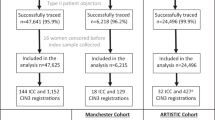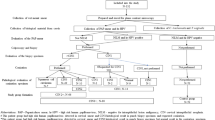Abstract
Trends in prevalence of cytological evidence of cervical intraepithelial neoplasia (CIN) and cervical infection with human papilloma virus (HPV), as indicated by HPV infection and dyskeratosis, were studied in 2,992 new attenders at a sexually transmitted diseases (STD) clinic between 1978 and 1982. Crude prevalence of CIN increased from 1.3% to 4.3% (P less than 0.001) and crude prevalence of HPV infection increased from 2.8% to 9.3% (P less than 0.001). Age adjustment had little effect on these trends. Review, in 1984-85, of samples of smears taken in 1978 and 1982 showed that recognition of koilocytosis by the laboratory had increased substantially over time while a tendency had developed to downgrade nuclear changes in the presence of koilocytosis. Correction of the 1978 and 1982 smear results to the 1984-85 classifications suggested that prevalence of koilocytosis had increased little (from 13.4% to 16.1%, P = 0.20) while there had been a substantial real increase in CIN (0.8% to 2.4%, P less than 0.001). To try to explain the trend in CIN, other characteristics of a sample of attenders at the STD clinic were studied. There were no appreciable trends in prevalence of past STD, number of sexual partners in the last 3 months, method of contraception, genital warts and culture of N. gonorrhoea, T. vaginalis, C. albicans and Chlamydia sp. from the vagina. There was an increase in the proportions in socioeconomic group I, as classified by postcode of residence (17.0% to 26.9%, P = 0.04), referred as contacts rather than with symptoms (24.0% to 41.6%, P less than 0.001), with a clinical diagnosis of genital herpes (5.0% to 8.6%, P = 0.08) and with herpes virus cultured from the cervix (2.1% to 6.3%, P = 0.03). The trend in prevalence of herpes virus infection was not explained by the other trends. It may explain the trend in prevalence of CIN.
This is a preview of subscription content, access via your institution
Access options
Subscribe to this journal
Receive 24 print issues and online access
$259.00 per year
only $10.79 per issue
Buy this article
- Purchase on Springer Link
- Instant access to full article PDF
Prices may be subject to local taxes which are calculated during checkout
Similar content being viewed by others
Rights and permissions
About this article
Cite this article
Armstrong, B., Allen, O., Brennan, B. et al. Time trends in prevalence of cervical cytological abnormality in women attending a sexually transmitted diseases clinic and their relationship to trends in sexual activity and specific infections. Br J Cancer 54, 669–675 (1987). https://doi.org/10.1038/bjc.1986.225
Issue Date:
DOI: https://doi.org/10.1038/bjc.1986.225



